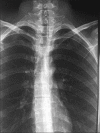Accidental inhalation of scarf pin: Presentation and management
- PMID: 32108599
- PMCID: PMC7065550
- DOI: 10.4103/lungindia.lungindia_345_19
Accidental inhalation of scarf pin: Presentation and management
Abstract
Background: The accidental aspiration of foreign bodies (FBs) is a rare occurrence in adults. However, inhalation of scarf pin is a phenomenon more and more common in the context of Muslim nations. The aim of our study was to describe the characteristics of this particular FB and illustrate the circumstances and consequences of inhalation.
Methods: This retrospective study involved patients with a history of scarf pin aspiration admitted to the Thoracic Surgery Department of Mohammed VI University Hospital Center, Oujda, Morocco, over a period of 10 years. Their main presentation, diagnosis, treatment, and outcome were analyzed.
Results: The average age of the 30 cases was 18 years (13-43). No antecedent was found in all cases. The penetration syndrome was found in all cases, with a transient moment of suffocation in 19 cases (63.33%), a dry cough in 15 cases (50%), minimal hemoptysis in 4 cases (13.33%), and purulent sputum in 3 cases (10%). The clinical examination was normal in all cases. The chest X-ray showed the FB in the form of linear right sided opacity in 14 cases (46.66%), left sided in 8 cases (26.66%), and in the trachea in 8 cases (26.66). Rigid bronchoscopy visualized the scarf pin at the level of the right basal pyramid in 5 cases (16.66%) and on the left side in 2 cases (6.66%), at the level of the main right and intermediate trunk in 7 cases (23.33%), at the level of the left main bronchus in 4 cases (13.33%) and in the trachea in 5 cases (16.66%). The pin was extracted by rigid bronchoscopy in 23 cases (76.66%) and was expelled spontaneously in 5 cases (16.66%). Thoracotomy was required in 2 cases (6.66%). Medical treatment, including antibiotic therapy and short-course oral corticosteroids, was administered in all cases.
Conclusion: Scarf pin inhalation is common in women who wear the Islamic headscarf. Bronchoscopy is an important tool to manage these FBs, but the best prevention treatment is careful handling of these potentially sharp objects away from the mouth.
Keywords: Airway management; imaging; inhalation; rigid bronchoscopy; scarf pin.
Conflict of interest statement
None
Figures
References
-
- Zaghba N, Benjelloun H, Bakhatar A, Yassine N, Bahlaoui A. Scarf pin: An intrabronchial foreign body who is not unusual. Rev Pneumol Clin. 2013;69:65–9. - PubMed
-
- Hebbazi A, Afif H, El Khattabi W, Aichane A, Bouayad Z. Scarf pin: A new intrabronchial foreign body. Rev Mal Respir. 2010;27:724–8. - PubMed
-
- El Koraïchi A, Mokhtari M, El Haddoury M, El Kettani SE. [Rigid bronchoscopy for pin extraction in children at the children's hospital in Rabat, Morocco. Rev Pneumol Clin. 2011;67:309–13. - PubMed
-
- Hasdiraz L, Bicer C, Bilgin M, Oguzkaya F. Turban pin aspiration: Non-asphyxiating tracheobronchial foreign body in young Islamic women. Thorac Cardiovasc Surg. 2006;54:273–5. - PubMed
LinkOut - more resources
Full Text Sources




